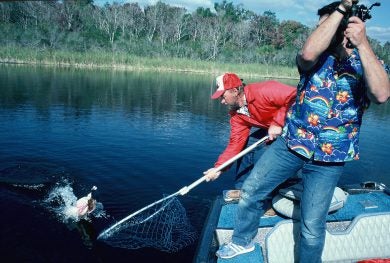How to Properly Net Fish
Bob McNally 06.30.16

Employed correctly, nets make for quick, easy fish landing. But when nets are mishandled, they become instruments of piscatorial nightmares, often resulting in lost or injured fish. The following tips should help your netting.
Netting Small Fish:
Many small fish (under 3 pounds) are destined for release, so care is the catch word here. Good nets for small fish are teardrop shaped, which are lightweight, compact, and easy-to-stow and handle. Small fish nets also should have a shallow mesh “pouch,” since a deep pouch can make untangling and unhooking small fish difficult.
It’s important a fish is completely played out before netting is attempted. When fish are properly played out they lay on one side, at the surface, fins fluttering weakly. As a tired fish is brought close, the net is submerged, open-end toward the fish. It’s led into a net head first, as the net is raised quickly and firmly.
Netting Big Fish:
Be certain the opening or “hoop size” of a net and its mesh “bag” are large enough to accommodate any fish you may encounter. If you have any doubts about a net handling, say, a 15-pound pike or 8-pound bass, you’re better off landing the fish by hand. The best nets for oversize fish have a wide teardrop-shaped “hoop,” with a deep mesh “pouch” or bag. Further, the best big-fish nets have a long, sturdy handle for reaching well away from a boat to collect a fish. Some fishermen prefer big-fish nets with telescoping handles since they stow easily aboard boats.
Netting big fish is a two-person job. Angler and netter should stand a few feet apart, watching each other and the fish, as it’s carefully brought near. Wait until the fish is totally played out, as large, active or “green” fish at boatside can befuddle even experienced netters.
When a fish is spent, an angler should “lead” it alongside the boat, heading it toward the open net, which is submerged and waiting for the fish. Done correctly, the fish gently swims right into the net, and the netter raises the hoop and mesh quickly, bringing it immediately into the boat.
No flailing or lunging at a big fish should be done with a net, which can fray line, dislodge hooks, or spook a fish into a sudden surge and break-off. If a fish surges with renewed strength at the boat, simply remove a net from water while the angler plays the fish a bit longer.
Tangles and Teeth:
Keep a taught line as a fish is netted, which keeps its head “up” so hooks are kept away from tangling net mesh.
Once a fish is safely in a net, be mindful of hooks, but quickly collar or “lip” the fish with your hands and remove it from the net. Then dislodge hooks from the fish with pliers.
Sometimes a netted large fish, or one badly hooked, must be placed on a boat deck before it can be taken out of the mesh. Do it quickly before the fish rolls or flops, which tangles teeth and hooks.
Nets having large-size mesh made of nylon can become a nightmare of tangled hooks (especially trebles), as well as fish teeth. Rubberized nets are best for reducing tangles, especially fish with oversize teeth, like pike, muskies, and lake trout. Fine mesh is good for preventing sharp spines, gill covers, and hinged corners of fish mouths from snaring a net.


